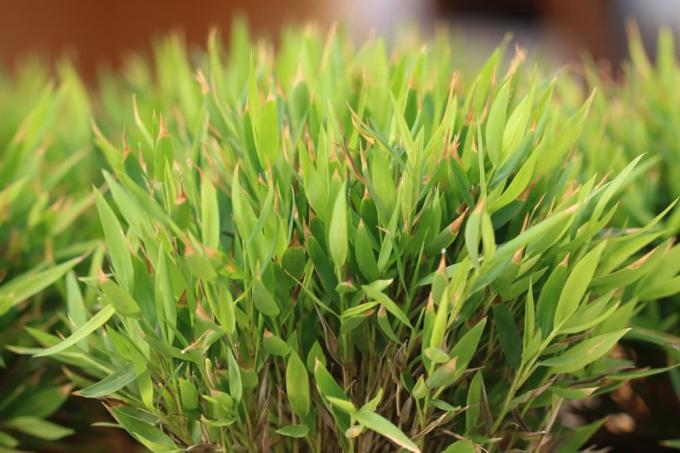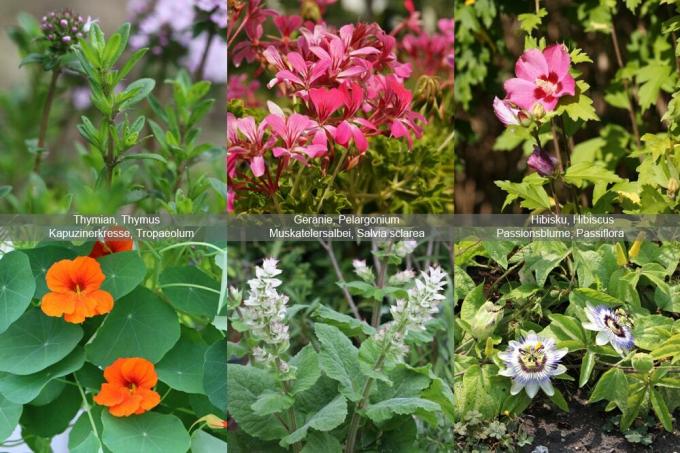

Table of contents
- Characteristics
- Plants non-toxic to cats
- indoor plants
- balcony and pot plants
- garden plants
- Non-toxic plants with added value for cats and humans
- cat grass
- More valuable plants for cats and humans
- Conclusion
Maybe your kitty's mysterious upset stomach just gave you the fright, maybe you want a new home for People, young cats and soon-to-be babies - there are households in which poisonous plants are best kept outside from the outset remain. Even if many of our common ornamental plants are poisonous, you can have a wonderfully green home without any critical substances design: Aside from the usual range of indoor plants, there is a large selection of non-toxic plants for the room, balcony and garden Disposal. Some of these plants not only offer decoration, but real utility, for cats and humans:
Characteristics
- Most indoor plants and many balcony and garden plants are foreign exotics
- This makes them dangerous for cats that nibble on plants
- No plants are safe from some cats because the cats are “animal bored”
- But even busy cats like to eat plants
- In fact, they should, because the plant material helps with digestion
- A mother cat cannot prepare her offspring for exotic imported plants
- Only cat owners who ban poisonous plants from the environment live a relaxed life
- This does not rule out a green environment, as there are many plants that are non-toxic to cats
- Which are just as non-toxic for humans, the baby can also discover more in the non-toxic house
- With the right plants, there is even a harvest for humans and cats
Plants non-toxic to cats
are available for any purpose and location:

indoor plants
- date palm, Phoenix dactylifera
- thick sheet, Crassula
- fringe bag, Crossandra
- kentia palm, Howea
- coconut tree, Cocos nucifera
- basket marante, calathea
- creeping pretty cushion, Callisia repens
- orchid Catleya, Catleya
- orchid moth, Phalaenopsis
- orchid tiger, oncidium
- orchid vanda, vanda
- orchid, odontoglossum
- penny tree, Crassula ovata
- shamrock, Aeschynanthus
- slanting plate, Achimenes
- flower mallows, Abutilon
- sword fern, Nephrolepis exaltata
- african violet, Saintpaulia ionantha
- christmas cactus, Schlumbergera
- maple, Abutilon
- room fir, Araucaria heterophylla
balcony and pot plants
- Fuchsia, fuchsia
- bluebells, campanula
- heather, erica
- Camellia, Camellia japonica
- Losbaum, Clerodendrum bungei
- slipper flower, Calceolaria
- glory flower, Clerodendrum bungei
garden plants
- bentgrass, Agrostis stolonifera
- foxtail grass, alopecia
- heather, erica
- jasmine, Jasminum nudiflorum
- catnip Hybrid, Nepeta faassenii
- timothy grass, phleum pratense
- Roses and all rose-like ones
- malva, mallows, the whole genus
- Sage, Salvia officinalis
- pansy, Viola wittrockiana
- marigold, tagetes
- Thyme, thymus
- star moss, Sagina subulata
Tip:
Not only plant toxins, but also fertilizers and chemical treatment e.g. B. with pesticides can kill the cat. So be careful with freshly bought plants, what does not come from the gardener you trust should not be accessible to the cat for the time being.
Non-toxic plants with added value for cats and humans
Saving yourself, pets, and young children from accidental exposure to any toxins around the home through judicious plant selection is sure to be a good thing. But you can also go one step further and equip your household with plants that bring real benefit to people and animals. There are also a wide variety of such plants, with very different uses:
cat grass
"Cat grass" is a must in a human-cat apartment, not only because it protects other indoor plants from being attacked or attacked by the house cat Being Eaten: Wild cats "graze" outside, digging deeply into the free-growing grass and eating it on too. According to the prevailing opinion, they do this to make the indigestible hairballs (bezoars) easier to be able to choke out after cleaning (or eating prey) in the form the digestive tract. If these hairs clump together in the gastrointestinal tract, it can, in the worst case, cause an intestinal obstruction. Other scientists suspect culinary motives or striving to absorb nutrients from plant components or see eating grass as an expression of boredom, but there is still no scientific evidence for these theses.

Quite different grasses are used and recommended as cat grass, here is a brief overview:
- Various cereal shoots such as barley, oats, millet, rye, wheat germ
- People can also help themselves here, for muesli, salad or green smoothies
- Various Cyprus grasses, e.g. B. Cyperus involucratus (often wrong as C alternifolius in the trade, popular compact cultivar 'Nana')
- Fresh Green Cyprus Grass (C eragrostis), Tall Cyprus Grass (C longus, Wild Galangal), True Papyrus (C papyrus) are also suitable
- The frequently recommended Cyprus grass Cyprus zumula is not the best choice as cat grass, but very hard and sometimes very sharp-edged
- If the cat (as usual) swallows the blades of grass whole in order to later retch them, the esophagus can be seriously injured
- An interesting alternative is the tiger nut, Cyperus esculentus, which forms tasty almond-like fruits for humans in the soil
- Most cats love C esculentus, even those who cannot tolerate normal cat grass
- Similarly interesting is nut grass, Cyprus rotundus: Cat grass for the cats, stoloniferous tubers with a hazelnut flavor for their humans
- Bamboo is also a grass and suitable as cat grass, some cats love it, some it is too hard
- Seychelles grass known as room bamboo "Pogonatherum paniceum" should rather be kept away from cats with its sharp edges
Tip:
There are other dangers lurking when choosing cat grass: if the already existing spider plant is also used as If cat grass is to be used (as is sometimes recommended), this is not such a good idea: the powerful air freshener Chlorophytum comosum filters various pollutants from the room air, and pollutant filters do not belong "in the cat". Front lawn can be poisonous to cats if infested with fungus (eg. B. German ryegrass Lolium perenne, Mushroom Neotyphodium lolii with poisonous Lolitrem B, but this is quite rare).
More valuable plants for cats and humans
There are recognized herbs for cats that people also like, and recognized medicinal plants for humans that are also good for cats. The following are non-toxic plants for cats and humans (for rooms, balconies, tubs and gardens) that can do more than clean cat stomachs:
- field mint, Mentha arvensis, the cat likes to nibble, can be used by humans like peppermint
- rush, Juncus, pond and houseplant from which you can weave baskets
- true valerian, Valeriana officinalis, attracts cats with the alkaloid actinidin, tea from the root calms the cat owner and his stomach
- real thyme, Thymus vulgaris: Kassler with honey and thyme crust, Boeuf Bourguignon, Piperade
- wild thyme, Thymus pulegioides, usable as regular Thyme + medicinal talents
- maidenhair fern, Adiantum capillus-veneris, indoor medicinal plant against cold + hoarseness
- Geranium, pelargonium, various rose and scented geraniums can be used to flavor drinks and sweet fruit preserves
- bluebells, campanula, Blossoms of all Central European species can be used as an edible decoration, young shoots as asparagus, leaves as a salad
- bee balm, Monarda didyma, humans and cats can eat the leaves fresh or cooked, humans also flavor desserts with the leaves or drink them as tea
- houseleek, sempervivum, gives cat's paws support on walls and roofs and is said to bring luck to human house owners.
- Hibiscus, Hibiscus rosa-sinensis, roots, leaves, flowers can be eaten raw or cooked
- jasmine real Jasminum officiale, usable as jasmine tea and fragrance oil
- bald boletus, Bougainvillea glabra, climbs several meters up its support in one season
- nasturtium, Tropaeolum majus, usable in the kitchen and as an indoor medicinal plant, medicinal plant of the year 2013
- cat germander, Teucrium marum, insider tip for cats and people who enjoy culinary discovery
- real catnip, Nepeta cataria, dried makes every cat toy interesting (again), man drinks catnip tea for cold, upset stomach and more
- creeping Jacob's ladder, Polemonium reptans, attracts cats with the smell of valerian and people with high decorative value and healing properties
- Lavender, Lavendula augustifolia, probably every animal and every human being likes it
- Marjoram, Origanum majorana, can be used as a kitchen spice and sedative for cats in heat (1 tsp dry herb, not for pregnant cats)
- lemon balm, Melissa officinalis can be used as a kitchen spice and as a system-supporting, neuroprotective food supplement for humans and cats
- mexican mountain palm, Chamaedorea elegans, non-toxic alternative to the cycad Cycas revoluta, "shade plant"
- clary sage, Salvia sclarea, medicinal plant and spice for humans and cats
- feverfew, Tanacetum parthenium, attracts cats and is said to prevent migraine attacks in humans
- orchid venus slipper, paphiopedilum, recommended as non-toxic for cats, but only uncritical in small doses, v. a. the calcium oxalate in foliage + stems can cause permanent damage
- orchid, yellow lady's slipper, Cypripedium calceolus, the only lady's slipper species that occurs naturally in Germany, may only be planted as a cultivated plant due to strict nature protection
- orchid, vanilla, Vanilla planifolia, evergreen climbing plant with beautiful flowers and edible yield: spice vanilla, which can also be harvested and fermented by us (project for advanced "plant hobbyists")
- passion flower, passiflora, sometimes described as toxic and sometimes as non-toxic; no wonder: the leaves contain toxic hydrocyanic acid glycosides, the fruits are edible (P caerula) to delicious (P incarnate, passion fruit)
- cobbler palm, Aspidistra, is used in TCM as a medicinal plant
- hollyhock, Alcea, the medicinal black hollyhock is also called apothecary's mallow
- spleen fern, asplenium, the genus represents several medicinal plants
- Violet, viola, the true violet Viola odorata was medicinal plant of the year 2007
- water mint, Mentha aquatica, another mint for cats, is one of the sacred herbs of the druids for humans
- citrus trees, citrus, non-toxic, but often useful as a fruit-bearing cat barrier because many cats avoid the citrus scent

Conclusion
Unfortunately, if you banish poisonous plants from the immediate vicinity of your family, they will not die out. If your cat is an outdoor cat, they will encounter poisonous plants outside - so you don't have to live in constant fear of your cat crawling home foaming at the mouth. Cats aren't toddlers who uninhibitedly put EVERYTHING in their mouths (especially outside where boredom doesn't arise). But that brings us to an important point: The plant-technically poison-free household does not prevent you from teaching children how to deal with poisonous plants. However, the advantage remains that the sensitization to toxic substances can be relaxed, e.g. B. when visiting a botanical garden - better than having to provide the information after a doctor's visit that would have saved this doctor's visit.
 Home editorial office
Home editorial office
Learn more about dogs, cats & small animals

16 cat-friendly houseplants
If you share an apartment with a cat, you should not have any poisonous indoor plants, because cats occasionally eat the greenery. There are many cat-friendly houseplants that are harmless and can recover quickly once a cat has bitten them.

Remedy for cat urine in the garden | 5 means to remove odor
Cats are popular pets, but cat urine in the yard can be a problem. Not only is the smell unpleasant, diseases can be transmitted via the excretions. Therefore, areas such as the vegetable patch or the play corner should remain free of cats.

Are rowanberries poisonous? | What to do if a dog eats rowan berries?
It is a widespread old wives' tale that rowan berries are poisonous. They clearly aren't. Still, unripe berries can lead to gastrointestinal problems. However, there is no danger to life and limb - neither for people nor for pets. More about this here.

Popular Male and Cat Names: 179 Male and 162 Female Names
Cats aren't really dogs whose upbringing is always the priority, but the new kitty should be given a name. Here are some cat name inspiration and suggestions.

Dogs barking: when is it a disturbance of the peace? – Information and judgments
Not all dogs bite, but all dogs bark. Depending on how pronounced the barking is, it can quickly become a problem and a disturbance of the peace. The law regulates precisely when an annoyed neighbor can take legal action against it.

Combat earwigs | 5 remedies against earworms in the apartment
Although earwigs, Dermaptera in Latin, are completely harmless and actually useful animals, the insects are still a cause for panic for many people when they appear in the apartment. Here you can find out how to get rid of the unloved crawlers.



